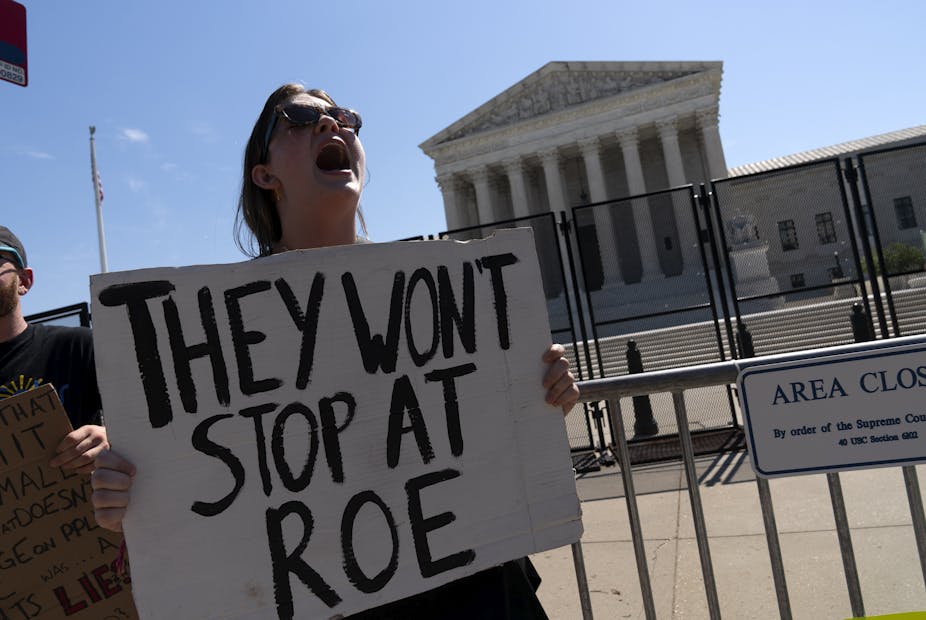It is a central principle of law: Courts, including the Supreme Court, are supposed to follow earlier decisions – precedent – to resolve current disputes. But on rare occasions, Supreme Court justices conclude that one of the court’s past constitutional precedents has to go, so they overrule it. This is exactly what happened in Dobbs v. Jackson Women’s Health Organization, when the court overturned Roe v. Wade, the 1973 ruling recognizing a constitutional right to abortion.
For years the court had been building up a theory of precedent reversal that would justify overturning Roe, among other precedents it did not like, and the draft opinion leaked in early 2022 foreshadowed this decision.
The justices who voted to overrule the Roe precedent provided the reasoning behind their decision to reverse a longstanding ruling and declare abortion rights are not protected by the U.S. Constitution. Their explanations also open up the possibility of more reversals of precedent in the future.
Why precedent?
Over the centuries, courts have stated many reasons they should adhere to precedent. First is the idea of equity or justice, under which “like cases should be decided alike.” If a court in the past reviewed a particular set of facts and decided a case in a specific way, fairness dictates it should decide another similar case the same way. Adhering to precedent promotes uniformity and consistency in the law.
In addition, precedent promotes judicial efficiency: Courts do not have to decide from scratch every time. They can look at similar cases from the past and base their reasoning on those decisions.
Finally, following precedent promotes predictability in the law and protects people who have come to rely on past decisions as a guide for their behavior.
Reversing precedent is unusual
The Supreme Court rarely overturns its past decisions or precedents.
In my book, “Constitutional Precedent in Supreme Court Reasoning,” I point out that from 1789 to 2020, there were 25,544 Supreme Court opinions and judgments after oral arguments. The court has reversed its own constitutional precedents only 145 times – barely 0.5%.
The court’s historic periods are often characterized by who led it as chief justice. From 1953 until 2020, under the successive leadership of Chief Justices Earl Warren, Warren Burger, William Rehnquist and now John Roberts, the court overturned constitutional precedent 32, 32, 30 and 15 times, respectively. That is well under 1% of decisions handled during each period in the court’s history.
When is precedent overturned?
For most of its history, the court changed its mind only when it thought past precedent was unworkable or no longer viable, perhaps eroded by its subsequent opinions or by changing social conditions. In some cases, reversal happened when the court simply thought it got it wrong in the past.
Not all precedents are equal, and several current Supreme Court justices have in the past been open to overturning even long-standing rulings that interpret the Constitution.
Beginning with the Rehnquist court, justices became more willing to reject precedents they thought were badly reasoned, simply wrong or inconsistent with their own sense of the constitutional framers’ intentions. Justice Clarence Thomas has taken this position on abortion. Justice Amy Coney Barrett, during her Senate confirmation hearing, argued that Roe is not a so-called superprecedent, a decision so important or foundational that it cannot be overturned.

Roberts has been willing to overturn settled law when he thinks the original opinion was not well argued. He did so in Citizens United, a 2010 decision overturning two major campaign finance decisions, Austin v. Michigan Chamber of Commerce from 1989 and part of the 2003 McConnell v. FEC decision.
In 2020, Justices Neil Gorsuch and Brett Kavanaugh in Ramos v. Louisiana went out of their way to explain and justify their views on when constitutional precedent may be overturned. They echoed Justice Samuel Alito’s discussion in 2018 in Janus v. American Federation of State, County, and Municipal Employees Council Number 31. All three justices said constitutional precedent is merely a matter of court policy or discretion, more easily overturned than a precedent about a law. Sometimes, they said, constitutional precedents can be overruled if later judges view them as wrongly decided or reasoned.
All of these comments foreshadowed the Dobbs opinion.
Reversing Roe v. Wade
Roe v. Wade was an important precedent. In 1973, the Supreme Court ruled that women have a right to terminate their pregnancies. That right was reaffirmed in 1991 in Planned Parenthood v. Casey, with Justices Sandra Day O’Connor, Anthony Kennedy and David Souter noting that an entire generation of women came of age relying upon their right to control their bodies and terminate pregnancies in most circumstances. The justices said it would be wrong to upset that expectation, declaring “An entire generation has come of age free to assume Roe’s concept of liberty in defining the capacity of women to act in society, and to make reproductive decisions.”
In the Dobbs decision, Alito, who wrote the majority opinion, said “Roe and Casey must be overruled.” His justification was that abortion rights are not mentioned in the Constitution, and protection of abortion rights is not “deeply rooted in this Nation’s history and tradition.” He also said Roe was not essential to the United States’ “scheme of ordered liberty” – or sense of personal freedom.
Alito also argued that Roe was “was egregiously wrong from the start. Its reasoning was exceptionally weak, and the decision has had damaging consequences. And far from bringing about a national settlement of the abortion issue, Roe and Casey have enflamed debate and deepened division.”
For Alito and the justices who joined his opinion – Thomas, Gorsuch, Kavanaugh and Barrett – the weakness and wrongness of the Roe decision simply outweighed the importance of the fact that women had relied on it for decades when making important personal decisions.
Kavanaugh wrote a concurring opinion that argued for reversing Roe for additional reasons. He wrote that the Constitution is silent on abortion – and therefore neutral on its constitutionality or unconstitutionality – so the court should be silent also. He declared that Roe was “egregiously wrong” and said it “has caused significant negative jurisprudential or real-world consequences.”
Finally, and perhaps most dramatically, Thomas’ concurrence declared that not only was Roe wrong, but the entire idea of the court recognizing the existence of constitutional rights not explicitly found in the text of the Constitution was flawed, an inappropriate expansion of rights that is known as substantive due process.
Thomas called for the court to reconsider the 1964 decision on the right of any couple to use birth control, the 2002 decision on the right of same-sex couples to engage in private consensual sexual acts and the 2014 decision on the right of same-sex couples to marry. All of these are presumably settled precedents. However, given Dobbs and the reasoning the various justices in the majority have offered, they too, along with others, could be candidates for reversal.
This is an updated version of an article originally published Sept. 20, 2021.

